AMD has officially announced its new lineup of high-performance workstation components: the Ryzen Threadripper 9000 Series processors and the Radeon AI Pro R9700 GPU. Announced at Computex 2025, these next-generation offerings are designed to tackle modern, compute-intensive workflows, including VFX, AI research, architectural visualization, and hardcore simulation workloads.
Improved Threadripper Design
The Ryzen Threadripper 9000 series marks AMD’s most advanced workstation CPU lineup to date. Built on the Zen 5 architecture, the chips scale up to 96 cores and 192 threads, pushing performance boundaries for professional creators and researchers. The architectural refinements include improved SMT efficiency, a fully optimized 512-bit AVX512 pipeline, and higher throughput in integer and floating-point workloads.
AMD promises significant generational improvements, boasting up to a 25% uplift across 10 key workstation benchmarks compared to the Zen 4-based predecessors. For industries relying on AI, digital twins, and generative design, this IPC jump is impressive.
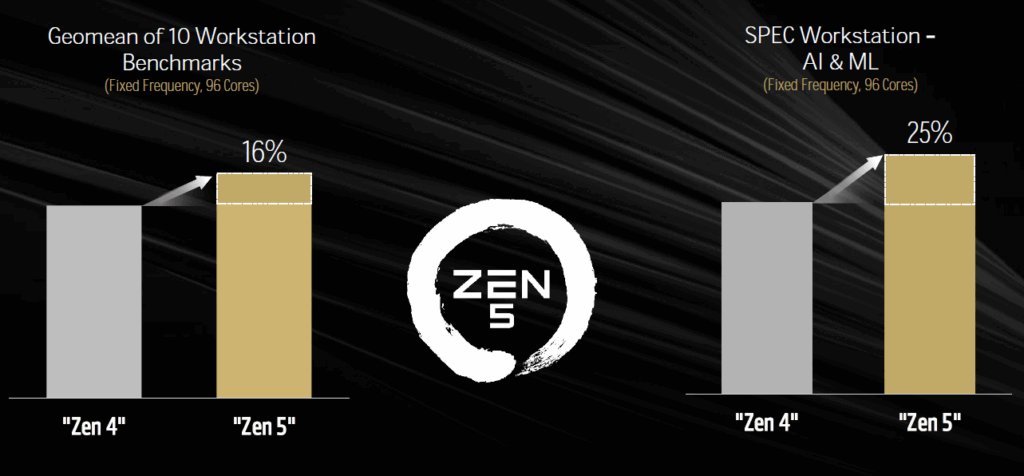
Ryzen Threadripper PRO 9000 WX-Series Lineup
Let’s take a quick look at the Threadripper PRO 9000 WX-Series lineup, which offers a range of high-core-count options aimed at professionals with diverse workload requirements. From the high-end 96-core 9995WX to the more accessible 12-core 9945WX, each processor is built on the Zen 5 architecture, supports PCIe 5.0, and shares a TDP envelope of 350W.
| Model | Cores | Threads | Base Clock | L3 Cache | PCIe | Socket | AMD PRO Technologies | TDP |
| 9995WX | 96 | 192 | 2.5 GHz | 384 MB | PCIe 5.0 | sTR5 | Yes | 350W |
| 9985WX | 64 | 128 | 3.2 GHz | 256 MB | ||||
| 9975WX | 32 | 64 | 4.0 GHz | 128 MB | ||||
| 9965WX | 24 | 48 | 4.2 GHz | 128 MB | ||||
| 9955WX | 16 | 32 | 4.5 GHz | 64 MB | ||||
| 9945WX* | 12 | 24 | 4.7 GHz | 64 MB |
Despite the internal upgrades, the 9000 series maintains compatibility with the sTR5 socket, making this a mostly drop-in upgrade for existing Threadripper users. Supporting up to 128 I/O PCIe Gen5 lanes and eight channels of DDR5-6400 ECC RDIMM memory, this platform is specifically designed for high-end, bandwidth-intensive environments.
A few quality-of-life improvements also stand out, such as refined power gating for improved efficiency, a new branch predictor, and a faster cache hierarchy, ranging from the 48KB D-Cache to 32MB of L3 per CCD.
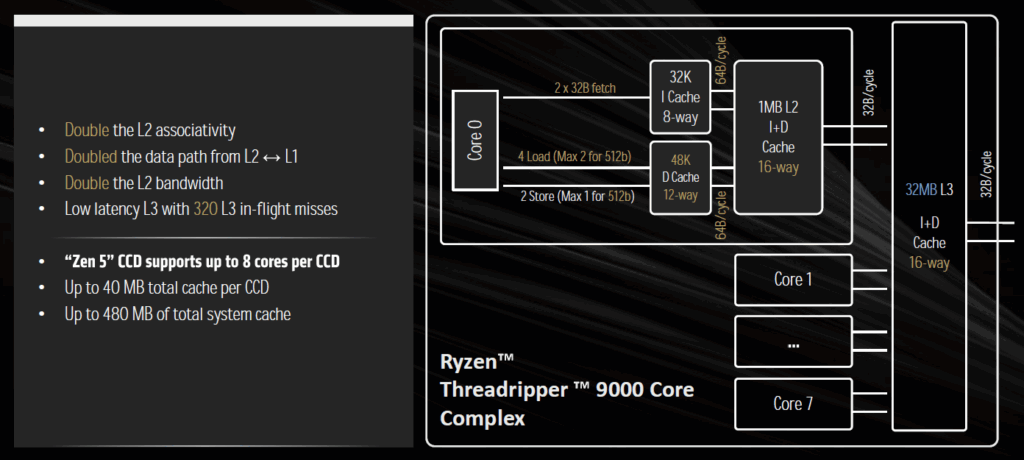
Threadripper PRO 9995WX Real-World Results
AMD says that its new PRO flagship, the Threadripper PRO 9995WX, can easily compete with Intel’s 60-core Xeon W9-3595X, indicating that it comes out ahead in nearly every benchmark shared. AMD boldly claims that it can deliver up to 145% faster rendering in V-Ray, 118% gains in Cinebench, and a 78% speed-up in Adobe After Effects. Those are huge gains, particularly for studios relying on render farms and real-time editing pipelines.
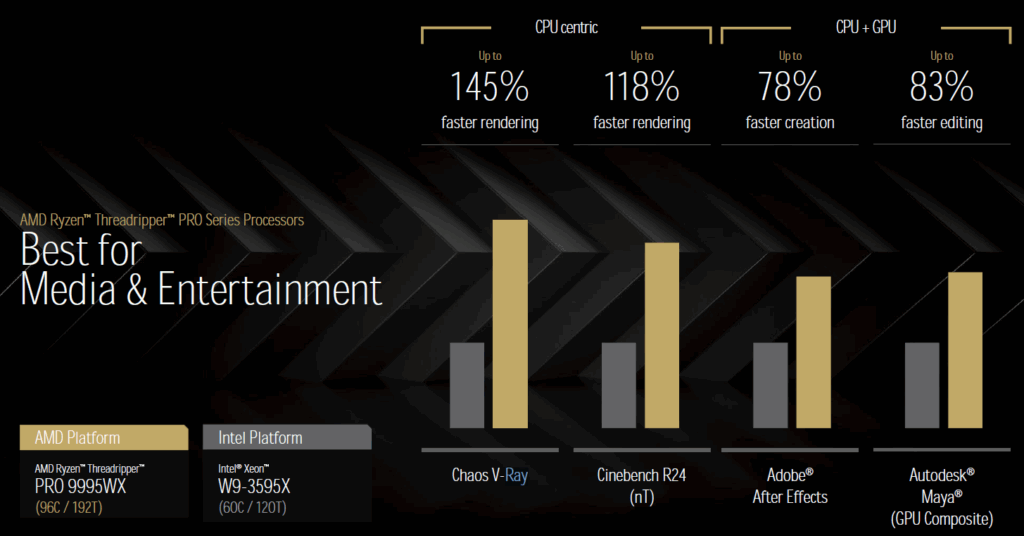
From media and architecture to scientific research, these new chips are certainly designed to easily handle demanding workloads, whether they rely on the CPU, the GPU, or a mix of both.
The Radeon AI Pro R9700 GPU
On the GPU side, the new AMD Radeon AI Pro R9700 has some pretty impressive specs. Equipped with 128 AI accelerators, this card is built with AI workloads in mind and features 32GB of high-speed GDDR6 memory, a total of 64MB Infinity Cache, and supports 1531 TOPS of INT4 sparse performance. This surpasses the previous-gen Radeon PRO W7800 by wide margins in their throughput tests.
The R9700 also delivers up to 4x the TOPS performance compared to the W7800, making it ideal for professionals running demanding inference models or multi-instance AI tasks.

Looking at FP16/BF16 matrix performance, the R9700 doubles the throughput with 1024 FLOPS/Clock/CU versus 512 on the W7800, leading to a total of 191.4 TFLOPS, which is more than twice the output. The introduction of FP8 support is also essential, as it wasn’t available at all in the W7800.
Even in INT8 and INT4 operations, the R9700 scales things up dramatically. It offers 4x more compute units per clock for both formats, resulting in 382.7 TOPS for INT8 and 765.5 TOPS for INT4. Additionally, the R9700 expands on core architecture features with support for structured sparsity.
As such, AMD states that its new GPU is designed for inference-heavy applications, ranging from local LLMs to real-time diffusion models.
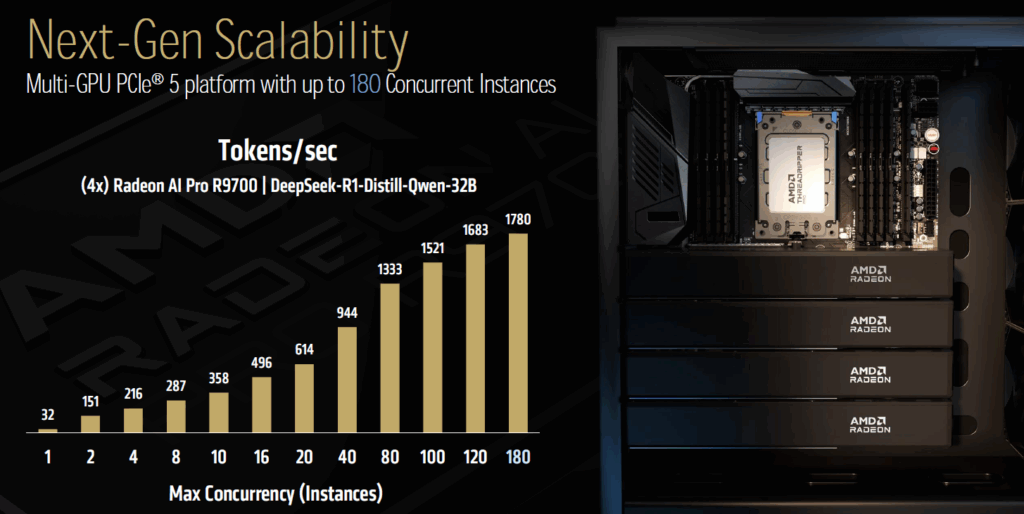
RDNA 4 Gets an AI Boost
AMD’s latest RDNA 4 architecture powers the R9700, now equipped with second-generation AI accelerators. These enhancements support structured sparsity and new 8-bit floating-point formats, providing improved inference performance for quantized, lower-precision models. Matrix operations and ray tracing performance are also enhanced, with double the triangle intersection units and BVH8 (BVH technology speeds up ray tracing by organizing 3D objects into nested boxes, letting the GPU skip entire sections of a scene that a ray won’t hit).
All this is packed into a chip built on TSMC’s 4nm node, with a die size of 356.5mm² and 53.9 billion transistors.
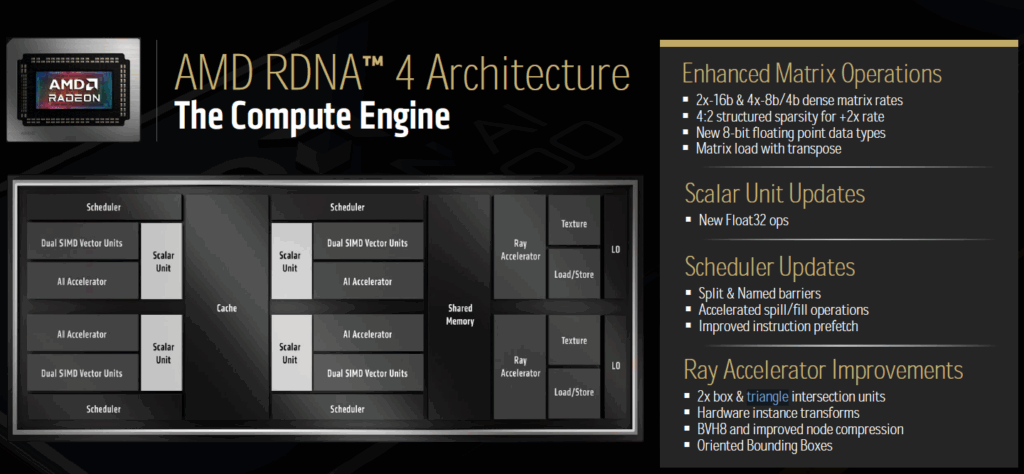
The Threadripper 9000 series and Radeon AI Pro R9700 are designed for power users, particularly those involved in training AI models, rendering high-end visuals, or running complex simulations. It’s impressive how much performance AMD delivers without requiring users to completely rebuild their systems, making it likely that these products will be quickly adopted in labs and other demanding environments worldwide.
If AMD prices the Radeon AI Pro R9700 close to their consumer GPUs, it could be a great alternative to the RTX 5090 or Blackwell Pro 6000, especially for local AI work. Intel’s upcoming Battlemage Pro cards are also worth watching. Both launches point to a growing trend of more affordable AI tools for hobbyists and professionals. We’re genuinely excited to see where this goes.




 Amazon
Amazon